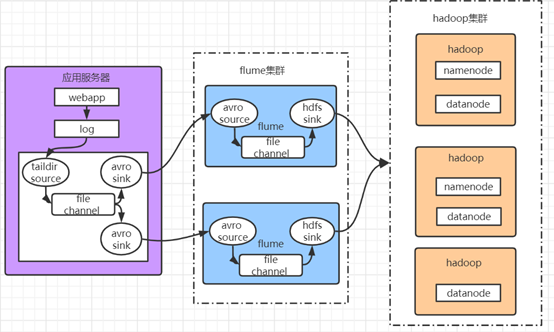第1章 集群规划
Flume集群,负载均衡和故障转移模式,笔者准备了3台机器安装了flume,其中webapp200是应用服务器,flume安装在这里,目的是收集应用服务器上的日志,通过2个avro sink分别对接到flume130和flume131机器;再通过flume130和flume131将数据传输到HDFS。(注:吞吐量大的channels可以换成kafka)。
|
|
Webapp200 |
Flume130 |
Flume131 |
| sources |
TAILDIR |
avro |
avro |
| channels |
file |
file |
file |
| sinks |
avro |
hdfs |
hdfs |
第2章 流程图

第3章 下载安装
3.1 下载地址
3.2 解压
解压到/opt/module/目录
$ tar -zxvf apache-flume-1.9.0-bin.tar.gz -C /opt/module/3.3 配置环境变量
配置JAVA_HOME
修改配置文件名称
$ mv flume-env.sh.template flume-env.sh修改Flume-env.sh
$ vi conf/flume-env.sh修改JAVA_HOME,修改成自己的JAVA_HOME
export JAVA_HOME=/opt/module/jdk1.8.0_221配置完后,将flume分发到其他机器
第4章 配置Agent
4.1 webapp200中的Agent
创建taildir-file-hdfs.conf,并添加如下内容:
# Name the components on this agent
a1.sources = r1
a1.sinks = k1 k2
a1.channels = c1
# Describe/configure the source
a1.sources.r1.type = TAILDIR
a1.sources.r1.channels = c1
a1.sources.r1.positionFile = /opt/module/apache-flume-1.9.0-bin/position/taildir_position.json
a1.sources.r1.filegroups = f1
a1.sources.r1.filegroups.f1 = /opt/logs/info*.log*
# Describe the sinkgroups
a1.sinkgroups = g1
a1.sinkgroups.g1.sinks = k1 k2 k3
a1.sinkgroups.g1.processor.type = load_balance
a1.sinkgroups.g1.processor.backoff = true
a1.sinkgroups.g1.processor.selector = round_robin
a1.sinkgroups.g1.processor.selector.maxTimeOut=10000
#Define the sink k1
a1.sinks.k1.type = avro
a1.sinks.k1.channel = c1
a1.sinks.k1.hostname = flume130
a1.sinks.k1.port = 4545
#Define the sink k2
a1.sinks.k2.type = avro
a1.sinks.k2.channel = c1
a1.sinks.k2.hostname = flume131
a1.sinks.k2.port = 4545
# Use a channel which buffers events in memory
a1.channels.c1.type = file
a1.channels.c1.checkpointDir=/opt/module/apache-flume-1.9.0-bin/data/checkpoint/balance
a1.channels.c1.dataDirs=/opt/module/apache-flume-1.9.0-bin/data/balance
a1.channels.c1.capacity = 1000
a1.channels.c1.transactionCapacity = 100
# Bind the source and sink to the channel
a1.sources.r1.channels = c1
a1.sinks.k1.channel = c1
a1.sinks.k2.channel = c14.2 flume130和flume131中的Agent
# Name the components on this agent
a1.sources = r1
a1.sinks = k1
a1.channels = c1
# Describe/configure the source
a1.sources.r1.type = avro
a1.sources.r1.channels = c1
a1.sources.r1.bind = 0.0.0.0
a1.sources.r1.port = 4545
# Describe the sink
a1.sinks.k1.type = hdfs
a1.sinks.k1.channel = c1
a1.sinks.k1.hdfs.path = hdfs://hadoop100:9000/flume/events/%y-%m-%d/%H
a1.sinks.k1.hdfs.useLocalTimeStamp = true
a1.sinks.k1.hdfs.filePrefix = events-
a1.sinks.k1.hdfs.batchSize=100
a1.sinks.k1.hdfs.fileType=DataStream
a1.sinks.k1.hdfs.rollInterval=0
a1.sinks.k1.hdfs.rollSize=134217700
a1.sinks.k1.hdfs.rollCount=0
a1.sinks.k1.hdfs.round = true
a1.sinks.k1.hdfs.roundValue = 1
a1.sinks.k1.hdfs.roundUnit = hour
# Use a channel which buffers events in memory
a1.channels.c1.type = file
a1.channels.c1.checkpointDir=/opt/module/apache-flume-1.9.0-bin/data/checkpoint/balance
a1.channels.c1.dataDirs=/opt/module/apache-flume-1.9.0-bin/data/balance
a1.channels.c1.capacity = 1000
a1.channels.c1.transactionCapacity = 100
# Bind the source and sink to the channel
a1.sources.r1.channels = c1
a1.sinks.k1.channel = c1注意HDFS sink 需要放置相应的jar包和xml配置文件到flume目录下,下载和使用链接(笔者亲测有效,注意版本):flume hdfs sink所需jar包(flume1.9.0 hadoop3.1.2)
第5章 启动flume
启动命令
$ bin/flume-ng agent -n a1 -c conf -f job/taildir-file-avro.conf后台启动,在结尾加上&
$ nohup bin/flume-ng agent -n a1 -c conf -f job/taildir-file-avro.conf &再加上nohup可以把原本在console输出的运行日志输出在[当前运行目录]/nohup.out中
第6章 关闭flume
flume进程启动动没有关闭的命令,只能kill掉。
查看占用4545端口的进程ID
$ netstat -nap | grep 4545或者直接jps找到flume进程,然后kill
$ kill [pid]